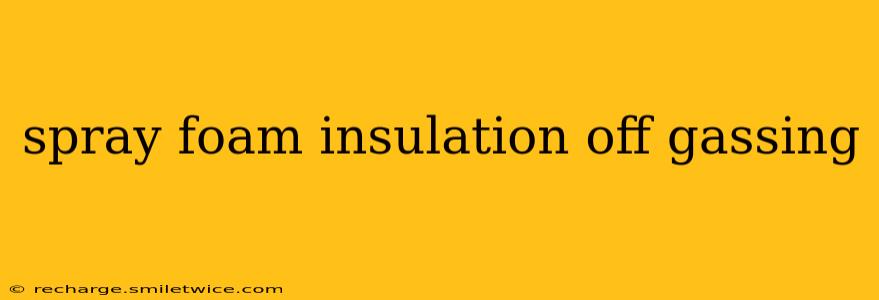Spray foam insulation, a popular choice for its energy efficiency and air sealing capabilities, has gained widespread use in residential and commercial construction. However, concerns surrounding off-gassing, the release of volatile organic compounds (VOCs), remain a significant topic of discussion. This comprehensive guide delves into the intricacies of spray foam off-gassing, addressing common questions and misconceptions to help you make informed decisions about your home's insulation.
What are VOCs in Spray Foam Insulation?
Volatile Organic Compounds (VOCs) are chemicals that easily evaporate at room temperature, releasing gases into the air. Many spray foam insulation products contain VOCs, primarily isocyanates during the curing process. The specific VOCs and their concentrations vary depending on the type of spray foam (open-cell or closed-cell) and the manufacturer's formulation. While some VOCs are naturally occurring, others are added during the manufacturing process to improve performance characteristics. The levels of these VOCs released into the air are a key concern for homeowners.
How Long Does Spray Foam Insulation Off-Gass?
The off-gassing period varies considerably depending on several factors, including the type of foam, the environmental conditions (temperature and humidity), the thickness of the insulation, and the ventilation within the space. Generally, the most significant off-gassing occurs in the first few days to weeks after installation. However, a low level of off-gassing can persist for months, or even longer in some cases, though the concentration typically decreases over time. Proper ventilation is crucial during and after installation to help mitigate the effects.
Is Spray Foam Insulation Safe After Off-Gassing?
Once the initial off-gassing period subsides, and proper ventilation has been maintained, most spray foam insulation is considered safe for occupancy. However, individuals with severe chemical sensitivities may still experience reactions even after the significant off-gassing phase. Choosing low-VOC or zero-VOC spray foam options can significantly reduce the risk of health issues related to off-gassing. Always follow the manufacturer's instructions and recommendations for ventilation and safety precautions.
What are the Health Effects of Spray Foam Off-Gassing?
Exposure to high levels of VOCs from spray foam insulation can cause a range of short-term and long-term health problems, including:
- Eye, nose, and throat irritation: This is one of the most common immediate effects of VOC exposure.
- Headaches and dizziness: These symptoms can be experienced during and shortly after installation if adequate ventilation isn't present.
- Nausea and vomiting: More severe reactions may include gastrointestinal distress.
- Respiratory problems: In some cases, prolonged exposure to high levels of VOCs can exacerbate asthma or other respiratory conditions.
- Long-term health effects: While less common, some studies suggest potential links between long-term exposure to certain VOCs and more serious health issues.
Important Note: The severity of these health effects depends heavily on the concentration of VOCs, the duration of exposure, and individual sensitivities.
What are the Differences Between Open-Cell and Closed-Cell Spray Foam Off-Gassing?
Open-cell spray foam generally has a higher VOC content than closed-cell foam, resulting in more significant initial off-gassing. Closed-cell foam, due to its denser structure, tends to off-gas less and at a slower rate. However, both types still release some VOCs. The choice between open-cell and closed-cell should be made considering your specific needs, budget, and any health concerns.
How Can I Reduce or Prevent Spray Foam Off-Gassing?
Several strategies can mitigate the impact of spray foam off-gassing:
- Choose low-VOC or zero-VOC spray foam: Opting for products with lower VOC emissions significantly reduces the risk of health problems.
- Ensure adequate ventilation: Proper ventilation during and after installation is critical to remove VOCs from the air. This may involve using exhaust fans or opening windows.
- Follow the manufacturer's instructions: Always adhere to the manufacturer's recommendations for installation and safety precautions.
- Post-installation air quality testing: Consider having the air quality tested after installation to assess VOC levels and ensure they are within safe limits.
This information should not be considered medical advice. If you experience health problems after spray foam insulation installation, consult a medical professional. Thorough research and informed decisions are key to ensuring a healthy and comfortable home.
